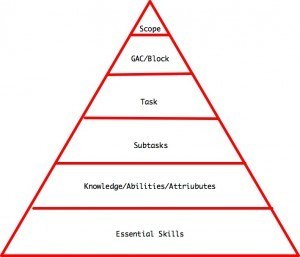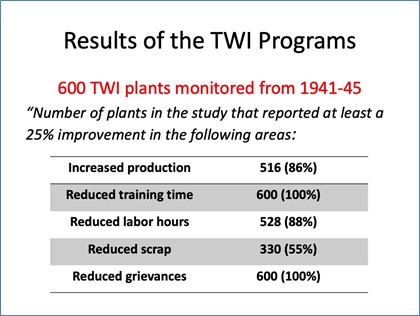DACUM… A Proven -Canadian- Way to Figure Out What The Heck People Need to Do
Jeff Griffiths, FCMC CTDP
As the battle for skilled workers accelerates across the globe, a lot of organizations will need to develop internal training programs to ‘grow their own talent’. The problem is, a lot of these same organizations aren’t entirely sure what it is that people in their organization need to do for the organization to be successful. I’m not talking about the broad strokes of that are found in most job descriptions, but the many additional and detailed pieces – the individual tasks, part-tasks and underlying/foundational skills and knowledge that allow someone to be successful in a role, and ultimately lead to the success of the organization.
So how do you figure all this out? One of the best ways to do this for many types of work, as practiced around the world and recognized by UNESCO-UNEVOC (the UN International Centre for Technical and Vocational Education) is DACUM.
DACUM (Developing A CUrriculuM is a Canadian success story. This comprehensive tool for job analysis and training design was developed in the late 1960’s by Dr Donald Glendenning and Larry Coffin of Holland College in PEI. It has since evolved into a comprehensive model for developing and managing competency. The Canadian Vocational Association and Dr Robert Norton at the Ohio State University Centre on Education for Training and Employment (CETE) have raised the profile of DACUM internationally, and it is now widely practiced around the world.
Essentially, the DACUM method is a group approach employing very experienced workers under the guidance of a trained DACUM facilitator to document the things that people need to be able to do in order to be considered competent in a job.

The DACUM method results in a hierarchy that describes the complete range of things that people do. It begins with broad duties or functions (called “General Areas of Competence or “GACs” in DACUM-speak). Most occupations will have between 7 and 10 GACs.
The GACs are further broken down into Tasks, which DACUM defines as “specific, observable units of work complete in themselves, with a definite start and end point, require two or more steps to accomplish, and when completed will result in a product, service or decision”. A worker could be paid piecemeal for a task.
A GAC usually contains between 5 and 30 Tasks.
Tasks can be broken down into the individual subtasks/part tasks or steps that must be taken to complete the task. Most training and skills analysis occurs at the Sub-task level.
Each subtasks has underlying skills and knowledge that is the foundation for learning. Generally, once things are broken down to the subtask level, the component knowledge and skills become quite obvious.
To run a DACUM session you need a group of experienced and proficient workers (5-12) who can work together to define the things they do. A skilled facilitator makes the process efficient and effective, and a very complete DACUM profile can be developed in short order.
Sequencing for Training
Once the DACUM profile is created, the next step involves organizing the skills, knowledge, subtasks, and tasks in a complexity hierarchy from easiest to most difficult. This is best done collaboratively with the same experienced workers that developed the profile.
We’ve found it helpful to rate tasks and subtasks in terms of their Danger, Criticality, Complexity and Frequency as an aid to determining an appropriate sequence for training.
| DANGER | This rating is intended to show the safety requirements of a task. On a scale of 1 (extremely low) to 5 (extremely high), the group is asked to rate the task or subtask on the basis of the safety risk. |
| CRITICALITY | This rating is intended to show how important the task is to the success of the operation. It rates the productivity loss, or additional costs associated with incorrect performance of the task on a scale of 1 (not very important) to 5 (extremely important) |
| COMPLEXITY | This rating is intended to show how difficult it is to achieve and maintain a sufficient level of proficiency. The scale ranges from 1 (easy to learn, easily retained) to 5 (difficult and lengthy to learn, and needs to be practiced often to remain proficient). |
| FREQUENCY | This rating is intended to show how frequently the task is performed. Many complex and difficult tasks are performed only rarely, and while they may be the “star” tasks of training programs, the ability to perform them is only marginally applicable to the actual job being trained. The scale ranges from 1 (rarely performed) to 5 (performed at least daily). |
The idea is to come make sure that the first things taught are the least dangerous, least complex, and most frequently performed tasks. This ensures that trainees quickly learn to be productive in some tasks – which reinforces their desire to learn and motivates them to keep going.
There are a number of firms who can provide DACUM facilitators (including ours!). In addition, the Canadian Vocational Association offers public training courses at various locations around the country throughout the year.
http://www.cva-acfp.org/en/dacum-model.html
DACUM has been used for over 40 years to develop occupational standards, apprenticeship training, and competency-based technical and vocational programs around the world. For a company wishing to create an internal training program, particularly for technical work, it is the best and easiest method in existence.
Read With Us
If you found this information useful, please subscribe to be notified for our next great post.








A well written post!